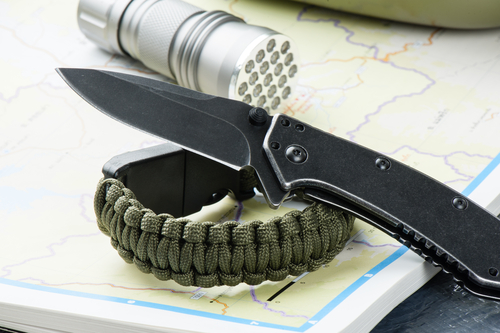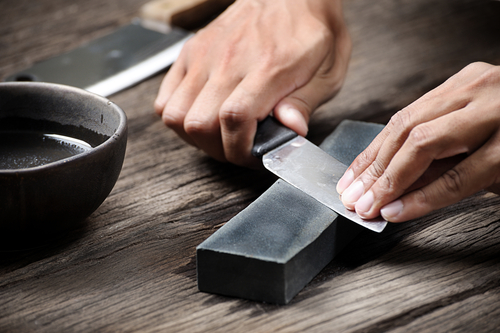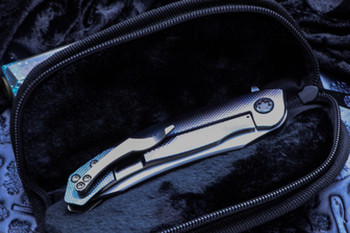Hiking with an EDC Knife: 9 Safety Tips to Keep in Mind
Sep 25th 2018
Hiking with an EDC knife—or everyday carry knife—is an excellent idea. It can cut clothing away from wounds, help you equally divide up snacks and even come in handy for self-defense in a pinch. However, a knife is only as safe as its user. Here are nine safety tips to keep in mind if you’re hiking with your EDC knife.

But first, what is an EDC knife?
An everyday carry knife is, as the name suggests, a knife that is easy to wear in everyday life. It is usually:
- Durable
- Multi-functional
- Lightweight
- Compact
- A good first-time or beginner knife
EDC knives are often folding knives. Because they’re easy to carry, they make an excellent choice for hiking trips.
Why hike with an EDC knife?
An EDC knife is the best pocket knife because it is lightweight and easy to pack, but its benefits don’t stop there. It can help you in a variety of ways, such as:
- Cutting or chopping food
- Cutting cord to hang food from branches and keep it away from animals
- Cutting paracord for hammocks or tarps
- Cutting emergency guy lines for tents out of string or cord
- Cutting away clothing, straps or gear from an entrapped casualty
- Cutting away clothing from messy wounds
In short, an EDC knife can be potentially lifesaving. Here are some tips to help you carry your knife safely.

1. Sharpen your knife.
A dull knife is more likely to slip, cause mistakes and accidentally inflict injury. Know how to safely sharpen your knife. Clean your knife as soon as you see any signs of debris, contaminants or rust. This will keep your knife sharper and safer for longer.
2. Store your knife safely.
Invest in quality knife storage. This protects your knife from the elements and helps minimize upkeep. It also protects it from opening in your pocket and keeps you, other people and your belongings safe on the trail.
3. Never put your knife away dirty.
Clean your knife after every use to protect it from rust and damage. Not only will it help your knife last longer, but it will keep the knife clean in case of an emergency. If you have to cut clothing away from a wound, a clean knife is far safer than a dirty knife.
After each use, wipe your knife clean. If you can, rinse the blade with water and dry it immediately. Never put a knife away wet.
4. Monitor your personal space.
Referred to as your blood bubble by this writer, your personal space when you’re using your knife includes anything your knife could reach if you stood up and held the knife at arm’s length. If someone enters your blood bubble as you’re using your knife, stop what you’re doing. This helps keep you and everyone around you safe.
5. Cut Away from your body.
Never slice or cut by pulling the knife toward you. If you miss, you could accidentally cut yourself. Instead, always cut away from you.
Additionally, be careful about how you hold the object you’re cutting. Make sure your fingers and thumb aren’t in the potential path of the knife.
This probably goes without saying, but never lay an object on your lap to cut, no matter how confident you feel. Put your elbows on your knees and work in front of yourself, carving away from your body or lay the object you’re working on down on a log or the ground.
6. Work slowly.
Concentrate on each step of the process: take out your knife with care, use it with caution, make sure you stop if anyone enters your blood bubble, clean your knife slowly and put it away carefully. No matter how used to the knife you are, pay attention to every step of the process.
7. Don’t push on the point of the knife.
Never push on the point of the blade—this is dangerous and your hand could slip. Instead, adjust your grip. See if you can change your hand position to achieve the desired effect.
8. Don’t run or climb with a knife.
If you run a greater risk of falling, put the knife down. Don’t run or climb with a knife in hand, as this is dangerous.

9. Take your knife to a professional.
If your knife is damaged, take it to be professionally repaired. This can help keep you safe on the trail: A professional repairman can restore your knife to its full and safe functionality.
Conclusion
An EDC knife can help make life run more smoothly while you’re out on the trail, but following these safety steps is important. Practicing proper knife safety can help make sure that the knife does help rather than harm. Stay safe and have fun while out on the trail. If you’re interested in purchasing an EDC knife, contact eKnives at (423)-525-9477 or visit our website. We can help you answer any questions you have and help you feel even more confident in the great outdoors.

